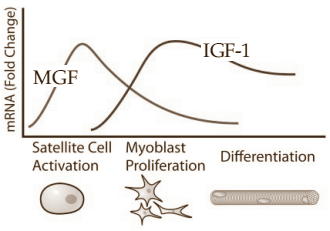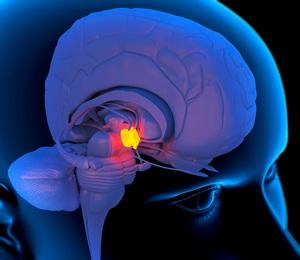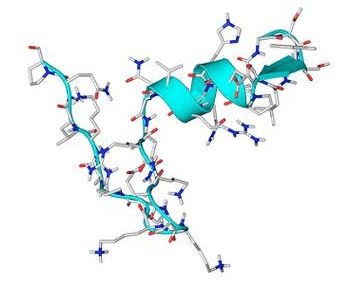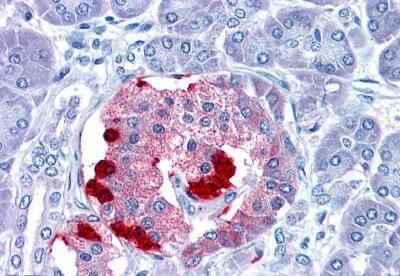
How Ipamorelin Works
Though this and all other peptides may seem confusing and intricate at first glance; its mechanism of action will soon make perfect sense once you review its individual components as follows.
How Growth Hormone Grows Muscle
For some, this subtopic is going to be the most important as it’s typically those who wish to develop their aesthetics who seek to utilise growth hormone secretagogue varieties such as ipamorelin.
Interestingly, it isn’t growth hormone per se that actually leads to the development of lean muscle tissue; muscular anabolism is simply one of the “side effects” of its release.
Ultimately, the reason why growth hormone is beneficial for those who wish to develop lean muscle mass is because when it enters the bloodstream, it triggers the release of a hormone called “IGF-1” (Insulin like Growth Factor 1) by the liver.- It’s this growth hormone “derivative” that subsequently splits itself into two following muscular breakdown and instigates the anabolic process of repairing and evolving muscle cells.
When IGF-1 “splits” – it forms two IGF 1 substrands, one of which is highly anabolic and recruits satellite muscle cells to help repair and grow the damaged muscle tissue after training. It’s this substrand that really encapsulates the desirability of IGF-1 from an aesthetic / anabolic perspective on the whole. Without it; IGF-1 would be relatively meaningless in regards to the anabolic process in general.
 This substrand is known as “MGF” (Mechano Growth Factor.) You may already be familiar with the name, as this hormone “subtype” is a separate product in its own right, widely used by bodybuilders.
This substrand is known as “MGF” (Mechano Growth Factor.) You may already be familiar with the name, as this hormone “subtype” is a separate product in its own right, widely used by bodybuilders.
As such, it is actually IGF-1 that grows muscle through its own mechanism of action – growth hormone simply leads to the elevated release of this highly “desirable” factor of human growth.
How Ipamorelin Stimulates The Pituitary Gland
It’s through the stimulation of the pituitary gland that ipamorelin is able to show its “strength” and lead us to the end result that is an elevation of growth hormone levels within the body.
As per the manner in which it achieves muscle growth though; all is not necessarily as it seems.
As previously mentioned, there are actually two “growth hormones” within the body. One of which is the growth hormone that leads to the release of IGF-1 and cellular repair within every aspect of the body, the other is Growth Hormone Releasing Hormone.
In regards to this latter hormone; it does precisely as its name implies. It is used purely as a trigger for the release of the “main” growth hormone from the somatotrophic cells.
When we take ipamorelin, it enters the bloodstream and makes its way to the hypothalamus in the brain. The hypothalamus then sends a signal to the pituitary gland (the pituitary gland could be viewed as the central “control switch” of the body for all hormonal release) to release growth hormone releasing hormone.
 GHRH then progresses onto the somatotrophic cells, where it “activates” them, leading to the subsequent expulsion of human growth hormone.
GHRH then progresses onto the somatotrophic cells, where it “activates” them, leading to the subsequent expulsion of human growth hormone.
Ordinarily, we would only be able to release an amount of effectively accessible growth hormone that was proportionate to our body weight (as per the 1 mcg per kg of bodyweight principle) – any release surplus to this level would simply yield “wasted” growth hormone being present in our system.
This is where ipamorelin differs from other secretagogues. Through its inbuilt selectivity, we can actually manipulate the pituitary gland into releasing an enormous surge of GHRH (beyond the levels normally applicable when utilising a peptide) and in turn, force the somatotrophic cells into “emptying” their growth hormone stores.
Achieving this end result would only be possible with an enormous dose however, and depleting them to this extent would not be advisable due to the fact that it would place a fairly extreme degree of pressure on both the somatotropic cells themselves and the pituitary gland.
One study on young female rats did show that even when administered at a very high intake level, ipamorelin isn’t likely to diminish the body’s natural gh resources. It must be noted though that with this test being performed on a rat, it does not directly translate into human use; it should merely be treated as a potential indication.
With that said, an elevation of gh levels surplus to those achievable with the utilisation of GHRP 6 or GHRP 2 would still theoretically lead to surplus benefit, even though these levels would not have to be high enough to “drain” the body’s processes.
You could potentially mimic the strength of, or come close to mimicking the strength of hexarelin when using ipamorelin in this fashion; though again the dose would have to be rather high.
How The GH Pulse Works
Ultimately, the growth hormone pulse whether naturally occurring or exogenously initiated relies entirely on the “hunger” hormone ghrelin. Or that is to say, it relies on the brain believing that ghrelin is present.
Under ordinary circumstances, we release ghrelin as a means of initiating growth hormone release to coincide with the intake of nutrients – this is precisely why it has been termed “the hunger hormone.” It releases as a means of telling us to eat (or scientifically speaking, to ingest nutrients.)
This mechanism finds its origins in our hunter-gatherer days, where we would go for long periods of time without ingesting food.
 During these early years, we had to forage / hunt for wild animals in order to acquire our nutrients. In the case of finding wild animals, this would often result in a life or death battle in order to secure a solid meal and the subsequent initiation of the “fight or flight” response.
During these early years, we had to forage / hunt for wild animals in order to acquire our nutrients. In the case of finding wild animals, this would often result in a life or death battle in order to secure a solid meal and the subsequent initiation of the “fight or flight” response.
Following the encounter, our body would be in desperate need of repair and recovery. Not only that, but even when stumbling across the likes of wild berries; our body would likely have been in a state of severe depletion by the time we were lucky enough to find them.
In either of these scenarios, the body would have had little choice but to capitalise on whatever nutrients we managed to forage (either animal or vegetable / fruit based) by releasing growth hormone to ensure that they all went into the sustenance of our vitality and future physical evolution.
Without digressing too much, it’s this necessary “capitalisation” on nutrient intake that ultimately kick starts the anabolic process leading to muscle growth too as a result of triggering the fight or flight response during training and the subsequent release of ghrelin and growth hormone.
As such, it’s through physical adaptation to external stress during our formative years as a race that we have evolved over thousands of years to “expel” ghrelin as a necessary precursor to growth hormone release.
In this instance, we are not necessarily talking about the release of ghrelin itself as a means of initiating the growth hormone release “chain” – rather, we are talking about emulating its effects.
 Whilst ipamorelin has been shown to elevate natural ghrelin levels following use (though not in anywhere the same league as GHRP 6 or even GHRP 2), it is actually through a process of “trickery” that it causes the pituitary gland to release GHRH (and subsequently growth hormone.)
Whilst ipamorelin has been shown to elevate natural ghrelin levels following use (though not in anywhere the same league as GHRP 6 or even GHRP 2), it is actually through a process of “trickery” that it causes the pituitary gland to release GHRH (and subsequently growth hormone.)
Following our previous explanation of peptides (and of course bearing in mind that ipamorelin is in fact a peptide) – you should already be aware that the unique amino acid code found in these protein derivatives lead to different cellular / neurological responses within the body.
As such, it should come as little surprise that the unique code in ipamorelin is capable of directly mimicking the neurological “radio signal” sent by the ghrelin hormone to the hypothalamus of the brain.
Following this, the brain (believing that ghrelin is requesting the release of growth hormone) then proceeds to follow its “normal” course of action by signalling the pituitary gland to release GHRH.
This is ultimately how the gh “pulse” is achieved when implementing ipamorelin.
How Ipamorelin Releases Ghrelin & Increases Gastric
 Ultimately, though ipamorelin is not actually ghrelin; it does elevate the presence of ghrelin in the system following implementation as a natural result of the neurological “excitement” it incites.
Ultimately, though ipamorelin is not actually ghrelin; it does elevate the presence of ghrelin in the system following implementation as a natural result of the neurological “excitement” it incites.
Realistically though, this natural elevation is minimal and fairly significant; it’s what ipamorelin actually does within the system following its release that is highly interesting.
When implementing any peptide variety, you’re placing your body in a scenario that is comparable to having a rapid and (at differentiating levels) sustained elevation of ghrelin levels beyond natural means.
This means that all of the positive benefits of ghrelin release are achieved; they don’t all relate to anabolism via the release of growth hormone either.
Some of the highlights on offer are:
- Advanced lipolysis (fat burning)
- Gastric motility (enhanced gastric / digestive movement)
- Enhanced bone metabolism
- Energy homeostasis
- Anti carcinogenic properties
These are only a few of the benefits at your disposal when using ipamorelin as a result of it successfully mimicking the ghrelin hormone.
Interestingly, when looking over the above benefits; you’ll likely notice that most of them are associated with growth hormone utilisation. As such, we once again find ourselves in a position where we may have been “tricked”.
This time however, we have not been tricked into thinking that growth hormone is anabolic (as per the hgh / IGF 1 comparison) we have instead been tricked into believing that it exerts all of these surplus benefits in its own right, when it is actually ghrelin (or the emulation of ghrelin) that achieves them.
You’ll notice recurrently that the introduction of ipamorelin achieves many benefits “passively”, as opposed to directly. Still, it leads to their manifestation nonetheless.
One such benefit, that of gastric motility, is particularly useful for those who are performing either a bulking or cutting cycle. Essentially, this enhanced motility is as a result of an increase in metabolic activity, which in part also enhances fat burning capacity.
The reason why metabolic capacity increases in this fashion is because the body “empties” the stomach and digestive tract as a result of the presence of ghrelin (or what it thinks is ghrelin) thus making way for more nutrients.
This leads to an optimal state of internal digestion whereas the entire digestive tract and stomach function in unison at their maximal capacity like a well-oiled machine.
When bulking this benefit is extremely useful being that it makes way for more nutrients by “emptying” the body regularly – for those who struggle to ingest a high calorie intake, this makes life far easier.
When cutting, an enhancement in metabolic activity / gastric motility is only going to lead to more calories being burned overall, thus enhancing the individual’s ability to achieve their overriding goals (reduced body fat / enhanced muscular visibility.)
Ultimately, this makes enhanced ghrelin presence / gastric motility useful for numerous reasons, all of which extend beyond “standard” anabolism.
Somatostatin Inhibition
One of the primary reasons why growth hormone peptides (including ipamorelin) trigger such a “positive” growth hormone response within the body is because they “overpower” and suppress somatostatin.
Somatostatin is a vital part of the growth hormone “recall” process.
Ordinarily speaking, once the somatotropic cells have released their growth hormone stores (following a “pulse”) the hypothalamus will then release somatostatin; it will directly signal the somatotrophs to cease their continued release of growth hormone.
 This is done as a means of preserving our natural growth hormone stores (and explains why “unrestricted” ipamorelin dosage could prove dangerous.)
This is done as a means of preserving our natural growth hormone stores (and explains why “unrestricted” ipamorelin dosage could prove dangerous.)
The initial surge and sustained release of growth hormone provided by ipamorelin is so powerful that it actually suppresses the functionality of somatostatin, thus meaning that it cannot “recall” growth hormone effectively.
This is part of the reason why ipamorelin has such a long half-life within the body, though the same could be said for all other growth hormone secretagogue types too.
It’s also the suppression of somatostatin that contributes to the massively enhanced release of growth hormone when using secretagogues compared to “organic” gh pulse levels.
If somatostatin were able to operate at its normal capacity when we used ipamorelin, it would inevitably diminish its effects. The reduction in its (somatostatins) effectiveness ultimately allows growth hormone to “reign supreme” during the course of ipamorelin introduction.

